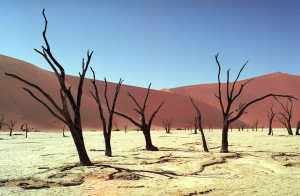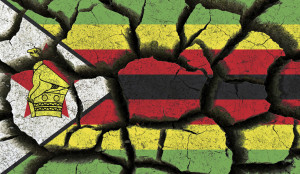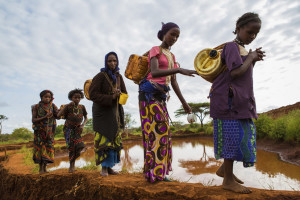Have you ever imagined that one day you may turn on the water faucet and nothing came out? Imagine if you had no water at all in your house, as if the water main was turned off for extended periods—maybe months. This scenario is a stark and possible reality. I know. I have lived through an African drought.
During my childhood, the seaside bungalow where my family lived in a remote area near Zululand, had not a single drop of running water. The water was not rationed—there was none to ration. The only water supply for bungalows then was from the rainwater that funneled from the sloped roofs into canvas water tanks attached to house sidings.
There was no such thing as bottled water; that luxury would come about much later. If we needed household water, we turned on the outside spigot, filled a pot, and then boiled the precious liquid before using it. Most seasons, we had abundant tropical downpours and water was plentiful, but no rain meant there wasn’t any water until another rainstorm.
During one summer, disaster struck. Someone slit the canvas water tank during the night; the receptacle had emptied. The nearest ‘fresh’ water was in a brackish lagoon that flowed into the Indian Ocean. Tropical broad-leafed trees met the sandy shores where venomous boomslange snakes lived; we saw the tracks. My mother and I retrieved buckets of river-sea water from the brownish tropical lagoon—home to crocodiles.
The memory of having no fresh water for such long periods has been the single-most cause of my being a life-long “water conserver.”
Now California is in drought mode. Governor Jerry Brown recently asked us to cut back water usage by 20%. A few recent rainstorms have helped somewhat, but reservoir levels are still low.
So what have I gleaned about the national and global water situation to prepare this piece? There are drought conditions in many parts of the Middle East, Africa, Australia as well as our Western states. Droughts and floods have been cyclical for millennia; nature just works that way. I learned that it may get worse in California if more rains do not come this season; one of the driest winter cycles in recent memory.
We may not experience the immediate effects of drought, but the ripple effect ripples far and wide. Many businesses have already cut water usage; ski resorts had a paltry season, and the drop in revenues have affected rentals, restaurants and seasonal workers. Snow pack runoffs will not sufficiently fill reservoirs.
As always, agriculture will suffer. Fields will dry, rivers may not flow, field hands will lose work, and produce prices will soar. The cattlemen are thinning herds and cutting back. Feed is scarce and expensive. If the drought continues and seasonal rains fail to come, parks, golf courses, sports fields and lawns will suffer, and withering gardens may have to go “native.”
Recycled grey water is already being used by carwash companies, ground irrigation, and light industry, and water restrictions have caused severe cut backs. The cost of water may rise.
Consumers in California are far from having household and potable water regulated, but experts warn that in the future there may be supply problems. The answer to high usage and dwindling fresh water supplies from rainfall may be mitigated by the process of desalination.
The desalination and reverse osmosis procedures to purify sea water have already been used for some time in such places as U.S. aircraft carriers, ships and submarines that use nuclear power to convert sea water to drinking water. An aircraft carrier desalinates as many as 400,000 gallons of salt water per day.
California is moving in the desalination direction to stave off possible water shortages. A huge desalination plant will be completed in 2016 in Carlsbad, projected to provide 7% of San Diego County’s fresh water supply. Poseidon Resources Corporation states that they have already gone through all regulatory procedures, and their new $1billion facility will process about fifty million gallons per day. Interior regions far away from coastal cities cannot gain from such desalination facilities as the transportation of desalinated fresh water to the inland is not cost effective.
Lockheed Corporation, on the cutting edge of weaponry production, and one of the nation’s largest government contractors, is developing salt water filters made of grapheme, similar to pencil lead. The nanometer filtration technology will be used to filter and remove microscopic salt particles and residue from sea water, and thus create top quality drinking water.
WATER AS A WEAPON
Countries systematically deprived of fresh water supplies may perish. Water, more than any other commodity, is the lifeblood of nations. There are countries today that are in desperate need of potable water, and with continual drought periods, will gradually face decline. Many African nations, Middle Eastern countries, and Australia have all borne the devastating results of the lack of rain. The poorest nations don’t have the finances or wherewithal to build monolithic dams to capture the rains in reservoirs, and many governments take drastic measures.
Zimbabwe, with a track record of government corruption, has withstood severe water woes. Water is rationed; absolutely no water flows through any pipes or comes out of any faucets, period. The pipes that usually flow with fresh water from municipal reservoirs are as dry as savannah bones. So how do Zimbabweans survive without water? They find ways.
There is a surge of water poachers and illegal H2O dealers that have sprung up overnight. Scavengers sneak to reservoirs or lakeshores at night and carry water in tricked-out trucks with huge water tanks and commercial barrels, and sell water of questionable quality, at 20 litres for $4.00.
One such town, Chitungwiza, with a population of two million, has had short water supplies during the long ration period. Some rural residents have their water turned on only once a week and have resorted to drinking acrid water from illegal boreholes; others walk to streams or lakes with buckets. Four thousand people died recently of cholera from drinking polluted, non-treated river or lake water. Parasitic and contaminated waters cause cholera, typhoid and bilharzia.
Some people have built tanks on the sides of huts and houses to harvest meagre rainwater roof runoffs. Farmers, even those who paid water bills, have been evicted from their land. The corrupt government claims there is no money to purify lake water for the poor areas. Yes, water can be used as a weapon.
There is another drought on another continent wreaking havoc in the outback. Over the past few decades, droughts have hit Australia hard. Half million head of sheep and cattle perished for the want of water. Restrictions of water and hosepipe uses have been enforced with heavy fines, and watering gardens has been verboten.
China is dry too. Last summer, a shattering heat wave caused the enforcement of water rationing in China’s central and eastern regions. A ton of fish perished at fish farms near Shanghai in 30 ponds that overheated, raising the water temperatures beyond what the fish could bear. The fish literally boiled in shallow ponds.
Parts of the Middle East, Yemen and Jordan are in drought mode; the latter being the world’s fourth driest water-poor nation. Many of these countries have the added burden of an influx of millions of refugees from war-torn Syria who live in transit camps. UNICEF reports that the need for millions of gallons of extra water adds strain on already-limited supplies. It costs money for fuel and labor to transport water.
According to a United States Intel report, water has become a global security issue. Competition for the power grab of dwindling water supplies could likely result in instability and potential state failures of America’s closest allies. With limited and non-sustainable water supplies food stockpiles would diminish. Water could potentially cost more than milk or the finest wines. Food could not be produced, livestock would die of thirst, and clean and affordable water would not be available to nourish nations.
This is not 1984 or Brave New World fiction; this is a stark reality of the possible future scenarios as we see the world population burgeon to over seven billion. Asia, the most densely populated region on earth, is blessed with water during monsoon seasons.
The destruction of a nation’s water supplies could deep-six the population within weeks. Weapons transportation and military manpower functions with water. The greatest weapon would be the strangulation or contamination of water supplies, and Governments could monitor water usage during droughts, and may even resort to detouring supplies from perceived enemy territory.
These situations are among the harshest scenarios, but experts foresee that this may not be so farfetched. We truly live in a thirsty world—both for land and man.
WATER USAGE
The State of California is encouraging conservation. The Sierra snowpack is meagre, reservoirs are shrinking, and concentrated mitigation may prevent future shortages. The town of Willits has already imposed a 150 gallon per day limit on residents, and reservoirs and aqueducts are scrutinized.
Golf courses use a whopping 360,000 gallons per day, and if the drought continues there may be restrictions on water recreation, and other consumers. In dry and desert regions, xeriscaping and succulent landscaping is recommended.
Visualize, if you will, your own daily water use in gallons. Imagine that each gallon you use is filled in virtual gallon containers stacked in your kitchen. Approximate usage, shower: 7 gals per minute; bath, 30 gals; running faucet, 3 gals per minute; washing machine, 50 gals per load; dishwasher, 15 gals; toilet, 6 gals per flush; brushing teeth/washing hands with running water, 3 gals per minute.
Not including garden or landscape watering, give or take a gallon or two, we use in excess of 150 gallons per day per person. Now imagine you have collected 150 one-gallon containers. In one month you will have filled 4,500 jugs. Multiply this by number of people in the household—this drives home the reality.
Buying bottled water on a regular basis adds to the problem. It takes, not only energy, but three liters of water to produce 1 liter of bottled water. Forty one billion litres of bottled water is consumed globally per year, and some is not even purified; much of it comes from faucets hooked to municipal water supplies.
Plus it takes energy and water to manufacture the light-weight plastic bottles made of polyethylene terephthalate (PET), a form of polyester made from fossil fuels. It takes unknown gallons of fuel to transport cases of bottled water, and untold gallons of water and fuel to convey and crush the spent receptacles into recycled cubes.
Keep in mind that plain old tap water costs about $2 per 1,000 gallons. So what do we actually pay for the convenience of buying bottled water? When we stop at the gas station we are shocked that gasoline is about $4 a gallon, but think nothing of paying $2 for a liter of ice-cold bottled water. At just under 4 liters to a gallon, we are paying $8 for a gallon of water—twice the price of gasoline. Think about it.

Leave a Reply